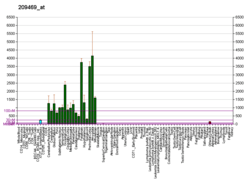GPM6A
Neuronal membrane glycoprotein M6-a is a protein that in humans is encoded by the GPM6A gene.[5][6][7]
References
- 1 2 3 GRCh38: Ensembl release 89: ENSG00000150625 - Ensembl, May 2017
- 1 2 3 GRCm38: Ensembl release 89: ENSMUSG00000031517 - Ensembl, May 2017
- ↑ "Human PubMed Reference:".
- ↑ "Mouse PubMed Reference:".
- ↑ Olinsky S, Loop BT, DeKosky A, Ripepi B, Weng W, Cummins J, Wenger SL, Yan Y, Lagenaur C, Narayanan V (Sep 1996). "Chromosomal mapping of the human M6 genes". Genomics. 33 (3): 532–6. doi:10.1006/geno.1996.0231. PMID 8661015.
- ↑ Liang YJ, Wu DF, Stumm R, Hollt V, Koch T (Jul 2008). "Membrane glycoprotein M6A promotes mu-opioid receptor endocytosis and facilitates receptor sorting into the recycling pathway". Cell Res. 18 (7): 768–79. doi:10.1038/cr.2008.71. PMID 18574501.
- ↑ "Entrez Gene: GPM6A glycoprotein M6A".
Further reading
- Boks MP, Hoogendoorn M, Jungerius BJ, et al. (2008). "Do mood symptoms subdivide the schizophrenia phenotype? association of the GMP6A gene with a depression subgroup". American Journal of Medical Genetics. 147B (6): 707–11. doi:10.1002/ajmg.b.30667. PMID 18163405.
- DeGiorgis JA, Jaffe H, Moreira JE, et al. (2005). "Phosphoproteomic analysis of synaptosomes from human cerebral cortex". J. Proteome Res. 4 (2): 306–15. doi:10.1021/pr0498436. PMID 15822905.
- Gerhard DS, Wagner L, Feingold EA, et al. (2004). "The status, quality, and expansion of the NIH full-length cDNA project: the Mammalian Gene Collection (MGC)". Genome Res. 14 (10B): 2121–7. doi:10.1101/gr.2596504. PMC 528928. PMID 15489334.
- Shin BK, Wang H, Yim AM, et al. (2003). "Global profiling of the cell surface proteome of cancer cells uncovers an abundance of proteins with chaperone function". J. Biol. Chem. 278 (9): 7607–16. doi:10.1074/jbc.M210455200. PMID 12493773.
- Strausberg RL, Feingold EA, Grouse LH, et al. (2003). "Generation and initial analysis of more than 15,000 full-length human and mouse cDNA sequences". Proc. Natl. Acad. Sci. U.S.A. 99 (26): 16899–903. doi:10.1073/pnas.242603899. PMC 139241. PMID 12477932.
- Mukobata S, Hibino T, Sugiyama A, et al. (2002). "M6a acts as a nerve growth factor-gated Ca(2+) channel in neuronal differentiation". Biochem. Biophys. Res. Commun. 297 (4): 722–8. doi:10.1016/S0006-291X(02)02284-2. PMID 12359212.
- Shimizu F, Watanabe TK, Fujiwara T, et al. (1996). "Isolation and mapping of the human glycoprotein M6 gene (GPM6A) to 4q33→q34". Cytogenet. Cell Genet. 74 (1–2): 138–9. doi:10.1159/000134401. PMID 8893821.
- Yan Y, Narayanan V, Lagenaur C (1996). "Expression of members of the proteolipid protein gene family in the developing murine central nervous system". J. Comp. Neurol. 370 (4): 465–78. doi:10.1002/(SICI)1096-9861(19960708)370:4<465::AID-CNE4>3.0.CO;2-2. PMID 8807448.
This article is issued from
Wikipedia.
The text is licensed under Creative Commons - Attribution - Sharealike.
Additional terms may apply for the media files.





